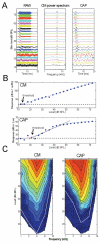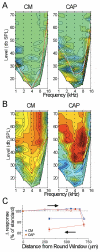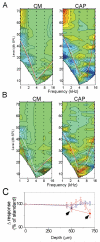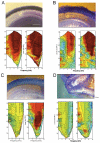Intracochlear recordings of electrophysiological parameters indicating cochlear damage
- PMID: 20818290
- PMCID: PMC3062515
- DOI: 10.1097/MAO.0b013e3181f1ffdf
Intracochlear recordings of electrophysiological parameters indicating cochlear damage
Abstract
Objective: : The pathophysiologic mechanisms resulting in hearing loss during electrode implantation are largely unknown. To better understand the functional implications of electrode implantation, we recorded the effects of cochlear damage on acoustically evoked intracochlear measurements using normal-hearing gerbils.
Methods: : A metal electrode was placed on the surface of the round window, and recordings of the cochlear microphonic (CM) and compound action potential (CAP) were made in response to stimulation with tone-bursts at various frequencies in 1-octave intervals and at intensities of 15 to 72 dB sound pressure level. The electrode was then advanced incrementally, with CM and CAP measurements obtained at each step. These data were compared with data obtained at the round window, and the electrode was withdrawn when a significant change was observed. After electrophysiological analysis, the cochlea was examined histologically.
Results: : Results show that on electrode insertion, loss of amplitude in the CM and CAP occurs after damage to cochlear structures. Loss of activity was typically first apparent in the CAP rather than the CM.
Conclusion: : These results suggest that a reduction of the CAP can be an early marker of interaction of the electrode with cochlear structures. Such measurements are potentially available with slight modifications to current cochlear implant technology.
Figures






References
-
- von Ilberg C, Kiefer J, Tillein J, et al. Electric-acoustic stimulation of the auditory system. New technology for severe hearing loss. ORL J Otorhinolaryngol Relat Spec. 1999;61:334–340. - PubMed
-
- Gstoettner WK, van de Heyning P, O’Connor AF, et al. Electric acoustic stimulation of the auditory system: results of a multi-centre investigation. Acta Otolaryngol. 2008;128:968–975. - PubMed
-
- Skarzynski H, Lorens A, Piotrowska A. A new method of partial deafness treatment. Med Sci Monit. 2003;9:CS20–24. - PubMed
-
- Simmons JA, Lavender WA, Lavender BA, et al. Target structure and echo spectral discrimination by echolocating bats. Science. 1974;186:1130–1132. - PubMed
-
- James C, Albegger K, Battmer R, et al. Preservation of residual hearing with cochlear implantation: how and why. Acta Otolaryngol. 2005;125:481–491. - PubMed
Publication types
MeSH terms
Grants and funding
LinkOut - more resources
Full Text Sources
Miscellaneous

